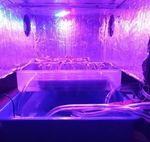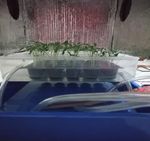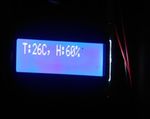Volume 10, Issue 6, June 2021 - IJIRSET
←
→
Page content transcription
If your browser does not render page correctly, please read the page content below
International Journal of Innovative Research in Science, Engineering and Technology (IJIRSET)
| e-ISSN: 2319-8753, p-ISSN: 2320-6710| www.ijirset.com | Impact Factor: 7.512|
||Volume 10, Issue 6, June 2021||
DOI:10.15680/IJIRSET.2021.1006035
Auto Hydroponic Growth Chamber for
Precision Agriculture
S.Raghul, B.V.Sribalaji, K.Vishnubalan, A.Velu
U.G. Student, Department of Electronics and Communication Engineering, Meenakshi Sundararajan Engineering
College, Chennai, Tamil Nadu, India
U.G. Student, Department of Electronics and Communication Engineering, Meenakshi Sundararajan Engineering
College, Chennai, Tamil Nadu, India
U.G. Student, Department of Electronics and Communication Engineering, Meenakshi Sundararajan Engineering
College, Chennai, Tamil Nadu, India
Assistant Professor, Department of Electronics and Communication Engineering, Meenakshi Sundararajan Engineering
College, Chennai, Tamil Nadu, India
ABSTRACT: Hydroponics is a method of growing plants without soil, by supplying mineral nutrient solutions in
water. By using this technique a farmer can cultivate one or more field simultaneously. In this paper we have designed
an indoor agriculture unit and have grown some plants in which nutrition management is done automatically by using
various sensors and micro controller unit.
KEYWORDS:Plant growth without soil, Automated indoor maintenance, Sensors, Water Solution
I. INTRODUCTION
The aim of this work is to style and construct an enclosed automatic hydroponic system that doesn't rely on the surface
climate. The designed system is capable to grow common variety of crops which will be used as a food supply within
homes while not the requirement of huge area. A microcontroller was operating as a brain of the system, that
communicates with different types of sensors to regulate all the system parameters and to reduce the human
intervention. The designed system is capable of maintaining healthy growing parameters for the plants with negligible
input from the user. The practicality of the general system was confirmed by evaluating the response from individual
system parts and observance them. This technique offers period of time notifications to alert the hydroponic syste m
user once the conditions don't seem to be favourable. So, the user will monitor many parameters while not exploitation
laboratory instruments, which can enable to regulate the whole system remotely. Moreover, the system additionally
provides a large vary of knowledge, that can be essential for plant researchers and provides a larger understanding of
however the key parameters of hydroponic system correlate with plant growth. The projected platform is used each for
quantitatively optimizing the setup of the indoor farming and for automating a number of the foremost labour intensive
maintenance activities. Moreover, such a observance system may doubtless be used for high-level higher cognitive
process, once enough knowledge are going to be collected.
II. RELATED WORK
The earliest written work on growing plants without soil was the 1627 book forest Sylvarum or 'A Natural History' by
Francis Bacon, printed one year after his death. Water culture became a well-liked analysis technique at that time. In
1699 John Woodward printed his water culture experiments with Mentha spicata. By 1842, a listing of 9 parts believed
to be essential for plant growth had been compiled, and also the discoveries of German botanists Julius von Sachs and
Wilhelm Knop, within the years 1859–1875, resulted in an exceedingly development of the technique of soilless cultivation.
Growth of terrestrial plants without soil in mineral nutrient answers was referred to as solution culture. It quickly became a
regular analysis and teaching technique and remains wide used.
IJIRSET © 2021 | An ISO 9001:2008 Certified Journal | 6057International Journal of Innovative Research in Science, Engineering and Technology (IJIRSET)
| e-ISSN: 2319-8753, p-ISSN: 2320-6710| www.ijirset.com | Impact Factor: 7.512|
||Volume 10, Issue 6, June 2021||
DOI:10.15680/IJIRSET.2021.1006035
III. METHODOLOGY
The system Consists of four sections viz., Light source unit, Temperature and humidity unit, Water Concentration unit, Alarm
unit. Arduino UNO is used as Microcontroller which regulates various sensors in the cir cuit. For wireless communication
HC-05 is a Bluetooth Module is used. 16X2 LCD is used as display unit.
Grow light for indoor plant allows to cultivate wide variety of plants at any climate during any season. They are substitute
natural sunlight, which simulate photosynthesis. We particularly choose LED instead of fluorescent, incandescent or HID
lamps for cost cutting measures and low heating structure.
Temperature and humidity unit maintains the optimum temperature and humidity levels. Temperature controls the rate of
plant growth. Enzymes which are responsible for chemical processes that helps in plant growth will perform better only under
certain temperature range. This optimum range varies slightly for different stages of growth. (22-28 degree C). Above and
below this range, enzyme activity starts to deteriorate and as a result chemical processes slow down or stopped. The
temperature of the plant environment should be kept at optimum levels for fast and successful maturation of crops. The ideal
water temperature for hydroponics is between 18 and 26 degree Celsius. From this temperature, plant can able to take desired
nutrient from the water. The Ph level of water solution must be maintained between 5.5 and 6.
Relative humidity is the percentage of amount of moisture the air could possibly hold. The relative humidity of the air
influences the transpiration rate of plants. High Humidity of the air causes less water to transpire from the plants, which
causes less transport of nutrients from roots to leaves. Relative Humidity should be between 50 to 70 %.
IV. EXPERIMENTAL RESULTS
Figures shows the results of plants grown in the chamber by the method of auto hydroponic agriculture and also shows the
auto monitoring system output which is measured by sensors. Fig. 2 show the data’s like (a) temperature and humidity in
air(b) shows the temperature and humidity in air, temperature in water, water level, pH in water and turbidity in water
(a) (b) (c)
(d) (e)
Fig. 1: (a) Overall model (b) Light OFF state (c) Loght ON state (d) Combination of plants (e) Plants at top view
IJIRSET © 2021 | An ISO 9001:2008 Certified Journal | 6058International Journal of Innovative Research in Science, Engineering and Technology (IJIRSET)
| e-ISSN: 2319-8753, p-ISSN: 2320-6710| www.ijirset.com | Impact Factor: 7.512|
||Volume 10, Issue 6, June 2021||
DOI:10.15680/IJIRSET.2021.1006035
(a) (b)
Fig. 2: Fig. 1: (a) LCD display output (b) Wireless device output
V. CONCLUSION
The concept of this hydroponic system is to maintain and control the environmental conditions and the efficient supply
of nutrition & water for healthy Plant Growth. In this paper, We designed a cost effective automated hydroponic system
using Bluetooth platform. The parameters of the system such as suitable temperature, light wavelength, pH, and the
required amount of water for the system were studied and calculated. This automated hydroponic system can provide
an in-house vegetation solution for the Technology world and its cost will be significantly less if the materials are
locally made. Therefore, anyone who stays even in cities or urban but wishes to do an indoor agriculture can adopt this
method to fulfil their local requirements of Fresh and Leafy Vegetables
REFERENCES
[1] Resh, H.M. Hydroponic Food Production: A Definitive Guidebook for the Advanced Home Gardener and the
Commercial Hydroponic Grower; 19 April 2016; CRC Press: Boca Raton, FL, USA, 2016; ISBN 1439878676 .
[2] Abdullah, N.-O. Vertical-horizontal regulated soilless farming via advanced hydroponics for domestic food
production in Doha, Qatar. Res.
[3] Crisnapati, P.N.; Wardana, I.N.K.; Aryanto, I.K.A.A.; Hermawan, A. Hommons: Hydroponic management and
monitoring system for an BLUETOOTH based NFT farm using web technology. In Proceedings of the 2017 5th
International Conference on Cyber and IT Service Management.
[4] Mehra, M.; Saxena, S.; Sankaranarayanan, S.; Tom, R.J.; Veeramanikandan, M. Bluetooth based hydroponics
system using Deep Neural Networks.
[5] Maldonado, A.I.L.; Reyes, J.M.M.; Breceda, H.F.; Fuentes, H.R.; Contreras, J.A.V.; Maldonado, U.L.
Automation and robotics used in hydroponic system. In Hydrocultural and Hydroponics Systems; IntechOpen:
London, UK, 2019.
[6] Lakhiar, I.A.; Gao, J.; Syed, T.N.; Chandio, F.A.; Buttar, N.A. Modern plant cultivation technologies in
agriculture under controlled environment: A review on aeroponics.
[7] Lakhiar, I.A.; Jianmin, G.; Syed, T.N.; Chandio, F.A.; Buttar, N.A.; Qureshi, W.A. Monitoring and control
systems in agriculture using intelligent sensor techniques: A review of the aeroponic system. J. Sens. 2018, 2018.
[8] Rius-Ruiz, F.X.; Andrade, F.J.; Riu, J.; Rius, F.X. Computer-operated analytical platform for the determination of
nutrients in hydroponic systems. Food Chem. 2014, 147, 92–97.
IJIRSET © 2021 | An ISO 9001:2008 Certified Journal | 6059International Journal of Innovative Research in Science, Engineering and Technology (IJIRSET)
| e-ISSN: 2319-8753, p-ISSN: 2320-6710| www.ijirset.com | Impact Factor: 7.512|
||Volume 10, Issue 6, June 2021||
DOI:10.15680/IJIRSET.2021.1006035
[9] Ibayashi, H.; Kaneda, Y.; Imahara, J.; Oishi, N.; Kuroda, M.; Mineno, H. A reliable wireless control system for
tomato hydroponics. Sensors 2016, 16, 644
[10] Eridani, D.; Wardhani, O.; Widianto, E.D. Designing and implementing the arduino-based nutrition feeding
automation system of a prototype scaled nutrient film technique (NFT) hydroponics using total dissolved solids
(TDS) sensor. In Proceedings of the 2017 4th International Conference on Information Technology, Computer,
and Electrical Engineering (ICITACEE), Semarang, Indonesia, 18–19 October 2017; pp. 170–175.
[11] Ruengittinun, S.; Phongsamsuan, S.; Sureeratanakorn, P. Applied internet of thing for smart hydroponic farming
ecosystem (HFE). In Proceedings of the 2017 10th International Conference on Ubi-media Computing and
Workshops (Ubi-Media), Pattaya, Thailand, 1–4 August 2017.
[12] Palande, V.; Zaheer, A.; George, K. Fully automated hydroponic system for indoor plant growth. Procedia
Comput. Sci. 2018, 129, 482–488.
IJIRSET © 2021 | An ISO 9001:2008 Certified Journal | 6060You can also read


























































